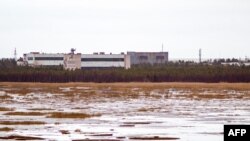On August 8, Russia’s TASS state news agency reported that a deadly explosion occurred during the test of a ballistic missile engine at a military facility near Severodvinsk, in the country’s Arkhangelsk region. While TASS cited the city authorities, who reported “a brief rise of the radiation level,” Defense Ministry officials quoted by the Interfax news agency the same day denied any leak of dangerous substances or abnormal levels of radiation.
It is possible that the Defense Ministry issued the denial before detecting the brief rise in radiation noted by the Severodvinsk mayor’s office.
On Thursday, August 8, the Russian media outlet RBC reported that the announcement about the radiation leak had been taken down from the city administration’s website. Their press service told RBC that the Defense Ministry was working on the issue and that it was their responsibility.
Whatever the case, several surviving victims of the blast reportedly are undergoing treatment for radiation-related injuries. The news aggregator Baza, earlier, named six victims who had suffered high doses of radiation and were being transferred to Moscow for treatment. Video showed emergency workers wearing hazmat suits during the evacuation and transportation of the victims. However, their gear may have been for protection from other hazardous chemicals that may have been released by the explosion.
Without additional details, it is not possible at this time to determine or verify exactly what happened. Still, an important question is what kind of rocket engine would release radiation if it exploded. The TASS story refers to a “liquid-propellant jet engine,” but this would not explain the radiation, especially if the surviving victims were indeed exposed to high doses.
While it is unclear the failed test involved an engine for the nuclear-powered Burevestnik/SSC-X-9 “Skyfall” cruise missile, President Vladimir Putin boasted about that cruise missile during a 2018 speech. Polygraph.info fact-checked his claims at the time. While some experts believe it is impossible to create a working nuclear-powered cruise missile, others say it is at least theoretically possible. One of the main dangers about such a propulsion system, however, is leaking radiation.
The Moscow Times also noted the incongruence of reports claiming the failed test involved a liquid-fueled rocket engine and the radiation spike that occurred after the explosion.
The newspaper cited Greenpeace, which reported the level of background radiation 30 km from where the accident took place was 20 times higher than normal.
A Greenpeace activist said he expected the radiation would be detected as far away as Norway. However, the Moscow Times cited another expert who said the radiation would not affect anyone beyond the immediate site of the accident.
The story became murkier late Sunday, August 11, when the director of Russia’s Federal Nuclear Center acknowledged that the victims of the accident had been working with nuclear material. Originally, the Russian news site Fontanka reported that this was a “small reactor,” but later updated the story, correcting “reactor” to something akin to a “nuclear battery.”
Due to evident secrecy surrounding such technology, what actually transpired remains unclear.





